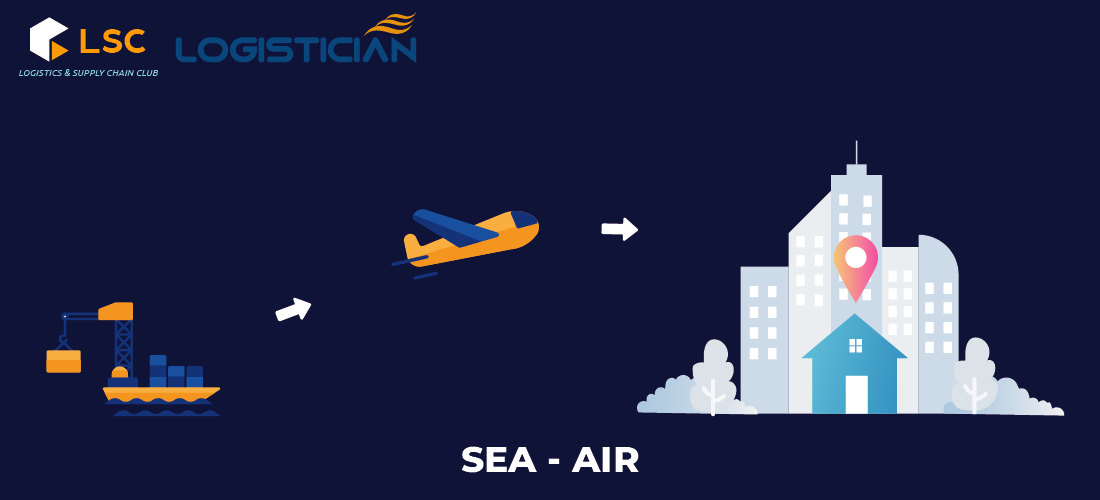What is multimodal transport?
With the development of international production and trade forms, a product will be circulated through many stages, many localities, and countries before reaching its destination. Therefore, multimodal transportation has become very popular in today’s world.
Multimodal transport is a mode of freight transport that combines two or more different modes of transport based on a single contract, a transport document, a mode of liability, and only one person responsible for the goods during transportation from the point of receipt to the point of delivery. Inside:
- The Multimodal Transport Operation (MTO) acts as a trustee and not as an agent of the shipper or agent of the carrier involved in multimodal transport.
- The MTO is responsible for the goods entire transportation process until the goods are handed over to the recipient (a liability regime). It can be a uniform liability regime or hop-by-stage (depending on agreement).
- In international multimodal transport, the place of receipt and delivery are usually in different countries, and the goods are usually transported using transport such as containers, trailers, etc.
For example, a parcel can be transported by road to the port to put on a ship to be transported to the receiving port, and then loaded on a railway carriage to the warehouse.
Benefits of multimodal transport
The core values brought by multimodal transport can be mentioned as:
- The ability to provide “door-to-door” service by connecting modes as well as coordinating vehicles on a complex transportation journey.
- Reducing logistics costs by taking advantage of each type of transport, which reduces the cost of goods while increasing competitiveness in terms of price and quality of goods.
- Expanding the transport network and having high economic efficiency thanks to the coordination of transport modes capable of carrying large volumes of goods, oversized and super-heavy goods.
- Manufacturing and trading enterprises quickly access the market, especially the international market through a large and highly connected transport network.
- Close cooperation between government and businesses.

Popular forms of multimodal transport today
Today’s shipping methods are also more diverse and richer, helping businesses with freight transportation needs have more options, which may be mentioned:
Sea transport model – air transport
This combined transport model will ensure the economics of ocean freight along with the speed of air transport, which is suitable for high-value goods such as electronics and highly seasonal goods such as clothes, toys, shoes, etc.
When goods are transported by sea to the port and then have to move inland quickly. To ensure the seasonality as well as the quality of goods, air transport will be the most appropriate means compared to other means of transport.

Model of road transport – air transport
This transport model combines the mobility of road transport and the speed of air transport, which is very popular when performing Express small packages, high value, fast transport, mail, important documents, etc.
Road transport meets the needs of consolidation and distribution of cargo at the beginning and end of the transportation process. Commodity will be concentrated at the airport for long-haul flights, to meet the gathering time to transport goods quickly.

Model of rail transport – road transport
The combination of these two models take advantage of safety and speed of rail transport along with the mobility and flexibility of road transport. This form was first born in the US, called Piggyback.
Trucks play the role of collecting and distributing goods at both ends, while rail transport will take on the main leg transport for greater convenience and safety. However, one limitation of this model is that it can only be accepted with contracts of the carriage when the delivery point has a railway crossing.

Model of rail/road/inland waterway transport – sea transport
This is the most popular transport model for transporting import and export goods. Cargo are transported by rail, road, or inland waterway to the seaport of the exporting country then transported by sea to the port of the importing country and transported from there to the consignee inland by road, rail, or inland waterway transport.

This model is suitable for all types of containerized cargo on transport routes that do not require urgent transportation time.
Model of transcontinental bridge
A transcontinental bridge, which is a land transport segment connected with sea routes, can be classified into four main categories:
- Landbridge: The rail system is used as a link between a foreign origin and destination. The continental mass is used as a link (bridge) between two maritime systems. The transport mode is almost exclusively rail because it offers faster long-distance service.
An example would be to ship a container from Japan to Europe by using the North American Landbridge as a way to bypass the detour imposed by the Panama Canal.

- Minibridge: Containers are transported from one part of one country to another, then transported by rail to the second port of destination according to a round-trip bill of lading issued by the ocean carrier.
For example, a shipment needs to be shipped from the Indian port of Mumbai to the US city of Colorado. But Colorado is a landlocked area, so it can only be shipped by sea to New York (USA), then transported by rail to Colorado.

- Microbridge: Similar to Mini Bridge, but Microbridge is different in that the final destination is not a port city but an industrial or commercial center in the interior.
For example, the shipment will be shipped by sea from the port of Busan in Korea to the US port of Los Angeles and will be transported by rail to the industrial park in Chicago.

Phan Quyen













